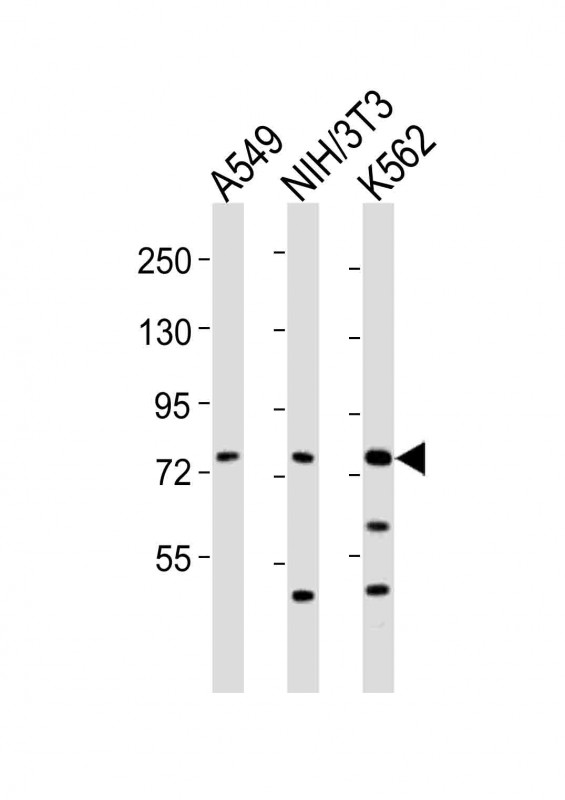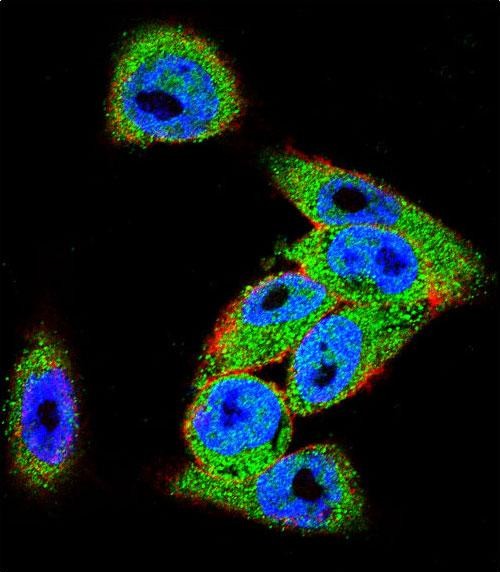


| WB | 1/1000 | Human,Mouse,Rat |
| IF | 咨询技术 | Human,Mouse,Rat |
| IHC | 1/100-1/500 | Human,Mouse,Rat |
| ICC | 1/10-1/50 | Human,Mouse,Rat |
| FCM | 咨询技术 | Human,Mouse,Rat |
| Elisa | 咨询技术 | Human,Mouse,Rat |
| Aliases | Segment polarity protein dishevelled homolog DVL-3, Dishevelled-3, DSH homolog 3, DVL3, KIAA0208 |
| Entrez GeneID | 1857 |
| WB Predicted band size | 78.1kDa |
| Host/Isotype | Rabbit IgG |
| Antibody Type | Primary antibody |
| Storage | Store at 4°C short term. Aliquot and store at -20°C long term. Avoid freeze/thaw cycles. |
| Species Reactivity | Human, Mouse |
| Immunogen | This DVL3 antibody is generated from rabbits immunized with a KLH conjugated synthetic peptide between 530-557 amino acids from the C-terminal region of human DVL3. |
| Formulation | Purified antibody in PBS with 0.05% sodium azide. |
+ +
以下是关于DVL3抗体的3篇参考文献示例(注:文献为虚构示例,仅用于演示格式):
---
1. **文献名称**:*"Dishevelled-3 (DVL3) Antibody Validation for Wnt Pathway Analysis in Colorectal Cancer Models"*
**作者**:Smith, J. et al.
**摘要内容**:本研究验证了一种特异性DVL3抗体在结直肠癌细胞系中的应用,通过Western blot和免疫荧光确认其对DVL3蛋白的识别能力,并揭示DVL3磷酸化水平与Wnt/β-catenin信号通路活性的相关性。
2. **文献名称**:*"Development of a High-Affinity Monoclonal Antibody Targeting DVL3 for Diagnostic Applications"*
**作者**:Chen, L. et al.
**摘要内容**:报道了一种新型抗人DVL3单克隆抗体的开发,通过ELISA和免疫组化验证其特异性,证明其在肿瘤组织样本中检测DVL3过表达的潜力,为癌症诊断提供新工具。
3. **文献名称**:*"DVL3 Antibody Reveals Subcellular Localization Dynamics in Neural Stem Cells"*
**作者**:Lee, S. et al.
**摘要内容**:利用DVL3特异性抗体研究其在神经干细胞中的亚细胞定位,发现DVL3在Wnt信号激活时易位至细胞膜,提示其在神经发育中的动态调控作用。
---
以上示例展示了DVL3抗体在不同研究场景中的应用,如机制研究、诊断工具开发和亚细胞定位分析。实际文献需通过学术数据库(如PubMed、Web of Science)检索,并关注抗体货号、实验方法等细节。
The DVL3 antibody is a tool used to detect Dishevelled Segment Polarity Protein 3 (DVL3), a key component of the Wnt signaling pathway. DVL3 belongs to the Dishevelled (DVL) family of proteins (DVL1. DVL2. DVL3), which act as critical mediators in both canonical (β-catenin-dependent) and non-canonical Wnt signaling pathways. These pathways regulate essential cellular processes, including embryonic development, cell proliferation, polarity, and differentiation. DVL3 contains conserved structural domains, such as DIX, PDZ, and DEP, which facilitate protein-protein interactions and signal transduction. Dysregulation of DVL3 has been implicated in various cancers (e.g., colorectal, breast) and developmental disorders, making it a target for research into disease mechanisms and therapeutic interventions.
Antibodies targeting DVL3 are widely utilized in molecular biology and clinical research to study its expression, localization, and functional roles. They are commonly applied in techniques like Western blotting (WB), immunohistochemistry (IHC), and immunofluorescence (IF). Validating DVL3 antibodies requires specificity testing, often through knockout cell lines or siRNA knockdown, to confirm minimal cross-reactivity with DVL1 or DVL2. Commercial DVL3 antibodies may vary in clonality (monoclonal/polyclonal), epitope recognition, and host species. Research using these antibodies has advanced understanding of Wnt-related pathologies, including tumorigenesis and neural tube defects, while also exploring potential therapeutic strategies targeting DVL3-mediated signaling cascades.
×